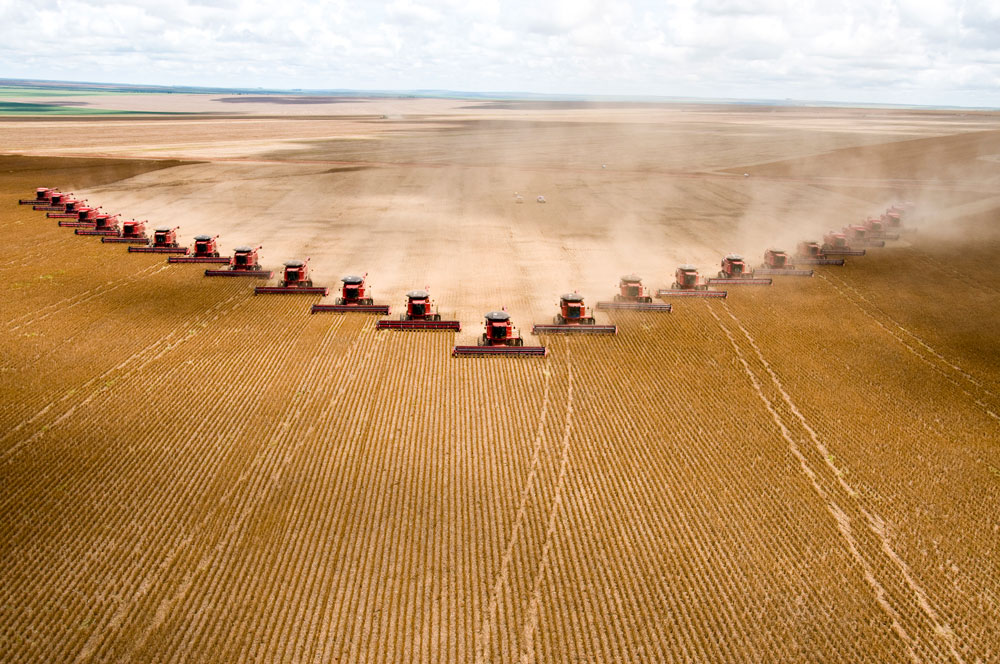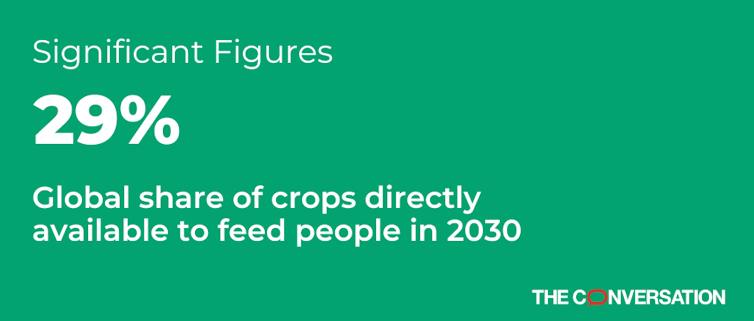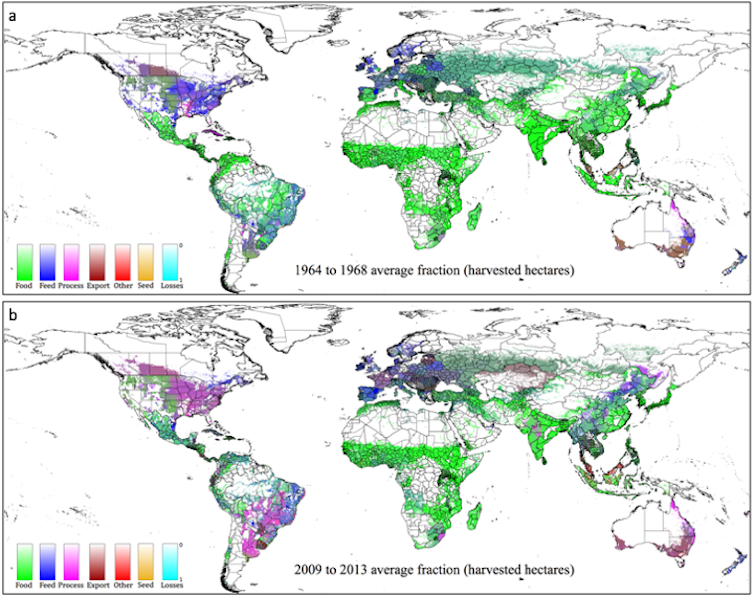
By Deepak Ray

Rising competition for many of the world’s important crops is sending increasing amounts toward uses other than directly feeding people. These competing uses include making biofuels; converting crops into processing ingredients, such as livestock meal, hydrogenated oils and starches; and selling them on global markets to countries that can afford to pay for them.
In a newly published study, my co-authors and I estimate that in 2030, only 29% of the global harvests of 10 major crops may be directly consumed as food in the countries where they were produced, down from about 51% in the 1960s. We also project that, because of this trend, the world is unlikely to achieve a top sustainable development goal: ending hunger by 2030.
Another 16% of harvests of these crops in 2030 will be used as feed for livestock, along with significant portions of the crops that go to processing. This ultimately produces eggs, meat and milk – products that typically are eaten by middle- and upper-income people, rather than those who are undernourished. Diets in poor countries rely on staple foods like rice, corn, bread and vegetable oils.
The crops that we studied – barley, cassava, maize (corn), oil palm, rapeseed (canola), rice, sorghum, soybean, sugar cane and wheat – together account for more than 80% of all calories from harvested crops. Our study shows that calorie production in these crops increased by more than 200% between the 1960s and the 2010s.
Today, however, harvests of crops for processing, exports and industrial uses are booming. By 2030, we estimate that processing, export and industrial-use crops will likely account for 50% of harvested calories worldwide. When we add the calories locked in crops used as animal feed, we calculate that by 2030, roughly 70% of all harvested calories of these top 10 crops will go to uses other than directly feeding hungry people.

Ray et al., 2022, CC BY-ND
Serving the affluent, not the poor
These profound changes show how and where agriculture and agribusiness are responding to the growth of the global middle class. As incomes rise, people demand more animal products and convenient processed foods. They also use more industrial products that contain plant-based ingredients, such as biofuels, bioplastics and pharmaceuticals.
Many crops grown for export, processing and industrial uses are specially bred varieties of the 10 major crops that we analyzed. For example, only about 1% of corn grown is the U.S. is sweet corn, the type that people eat fresh, frozen or canned. The rest is mostly field corn, which is used to make biofuels, animal feed and food additives.
Crops grown for these uses produce more calories per unit of land than those harvested for direct food use, and that gap is widening. In our study we calculated that industrial-use crops already yield twice as many calories as those harvested for direct food consumption, and their yield is increasing 2.5 times faster.
The amount of protein per unit of land from processing crops is twice that of food crops, and is increasing at 1.8 times the rate of food crops. Crops harvested for direct food consumption have had the lowest yields across all metrics of measurement and lowest rates of improvement.
Grow more foods that feed the hungry
What does this mean for reducing hunger? We estimate that by 2030, the world will be harvesting enough calories to feed its projected population – but it won’t be using most of those crops for direct food consumption.
According to our analysis, 48 countries will not produce enough calories within their borders to feed their populations. Most of these countries are in sub-Saharan Africa, but they also include Asian nations such as Afghanistan and Pakistan and Caribbean countries such as Haiti.
Scientists and agricultural experts have worked to increase the productivity of food crops in countries where many people are undernourished, but the gains so far have not been enough. There may be ways to persuade wealthier nations to raise more food crops and divert that extra output to undernourished countries, but this would be a short-term solution.
My colleagues and I believe the broader goal should be raising more crops in food-insecure countries that are used directly as food, and increasing their yields. Ending poverty, the U.N.‘s top sustainable development goal, will also enable countries that can’t produce enough food to meet their domestic needs to import it from other suppliers. Without more focus on the needs of the world’s undernourished people, eliminating hunger will remain a distant goal.
![]()
Deepak Ray is Senior Scientist at the University of Minnesota.




























Jimbo99 says
Ouch, that moment when you realize inflation in the USA is trending more Americans into “mismanaged poverty”. That ship sailed a long time ago. Feed the world ? The world is trying to cross our border. The grain goes into ethanol fuel. Own your Biden-Harris vote like a boss ?
tulip says
If you look at the graph whose page is highlighted in the article. this global food problem started in 2009. The chart compares 2009-2013 to the previous years before we had this problem. So Biden didn’t start it, not even Trump, as it was before they were presidents. However, neither Trump nor Biden, or any of the government did anything to correct the situation. Population growing by leaps and bounds, grains needed for bio fuels and other things, food needed to feed animals and chickens so we can eat. It’s a vicious cycle. It will all come to a head at some point when we have to make some hard choices. Meanwhile, we use much more electricity and, therefore much more fuel and energy to make electric cars and the batteries to keep them running, more and more immigrants, more and more babies, plus a lot of land has been destroyed by fire and drought so less crops are being grown.
Sometimes I envy the 50’s when I watch reruns of “Happy Days” when all these bad things weren’t a problem.
Sherry says
OOPS! I stubbed my toe. . . President Biden and Vice President Harris are to blame! Geez!!!
Not to confuse the cult members with actual “FACTS”. . . Republican George W. Bush was President when bio-fuels were rolled out in 2005. Both houses of Congress also had a Republican majority. I’m guessing they did not mention this on FOX:
In 2005, the U.S. Congress enacted a Renewable Fuel Standard (RFS) that set minimum requirements for the use of renewable fuels, including ethanol, in motor fuels. In 2007, the RFS targets were set to rise steadily to 36 billion gallons by 2022.
LikesFarming says
The article starts our good but goes all over the place then. Yes, about 1% of United States corn production is Sweet Corn for consumption. Sweet Corn equals about 2.5 Billion Pounds every year of production with Florida being the #1 producer of Sweet Corn, Iowa for total corn production followed by Illinois. “Field” Corn has always been produced yet the article makes it seem this is a new trend for purposes other than feeding humans. Think back to when many of us were younger and would pass a corn field with rows you could count, go past those same fields and you are hard pressed to tell the rows once the corn is shoulder height. As the population has grown so has production as well as farm management practices, better machinery, better fertilization, bigger markets etc. means more corn to industrial uses and animal feed as well as more Sweet Corn too. No one is going hungry because only 1% of the corn yield is Sweet Corn. As a side note Florida Sweet Corn is not as tasty as the Midwest produces.
R. S. says
Foreign aid is money, technical assistance, and commodities that the United States provides to other countries in support of a common interest of the U.S. and that country. Opinion polls consistently report that Americans believe foreign aid is about 25% of the federal budget, when it is actually less than 1%. As the world’s wealthiest nation, the U.S. provides more assistance than any other country, but a smaller proportion of its gross national product (GNP) than other wealthy nations. Historically, support for foreign aid has been bipartisan. [George Ingram, Senior Fellow – Global Economy and Development, Center for Sustainable Development] By Gross National Income, the US is far lower in a list of about 30 affluent nations. [Wikipedia]. Consider that the US has about 6 percent of the world’s population but about 60 percent of the world’s resources. And that’s not by the grace of any deity; it’s from taking a rich country away from one indigenous people and importing involuntarily another indigenous group to deliver the work.
joseph wittrock says
Deepak Ray says :
“For example, only about 1% of corn grown is the U.S. is sweet corn, the type that people eat fresh, frozen or canned. The rest is mostly field corn, which is used to make biofuels, animal feed and food additives.”
1) Biofuels……Fuel To take the food we eat to market? How would we get this food if we didn’t have fuel?
2) Animal Feed….so we can eat those animals? That’s our food’s food. That’s called “Food”
3) Food Additives….. Isn’t the first word food? So basically its “Food”
4) Bioplastic…..Our food has to have a container….right?
The Author, Deepak, must be a Senior “Rocket Scientist”.
Sherry says
Excellent credible facts RS! Thanks so much!
Unfortunately, many of the indoctrinated who read and comment on the articles in Flaglerlive care nothing for actual facts and reasonable, logical discussion.